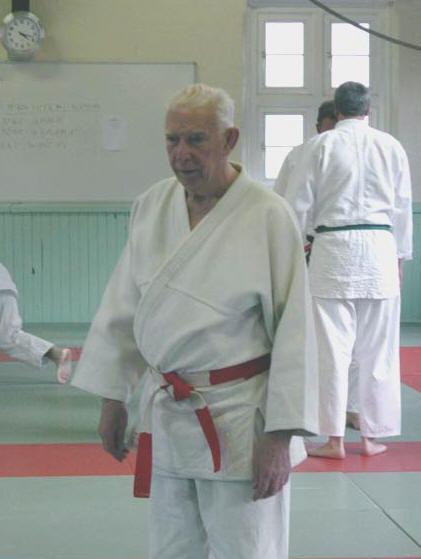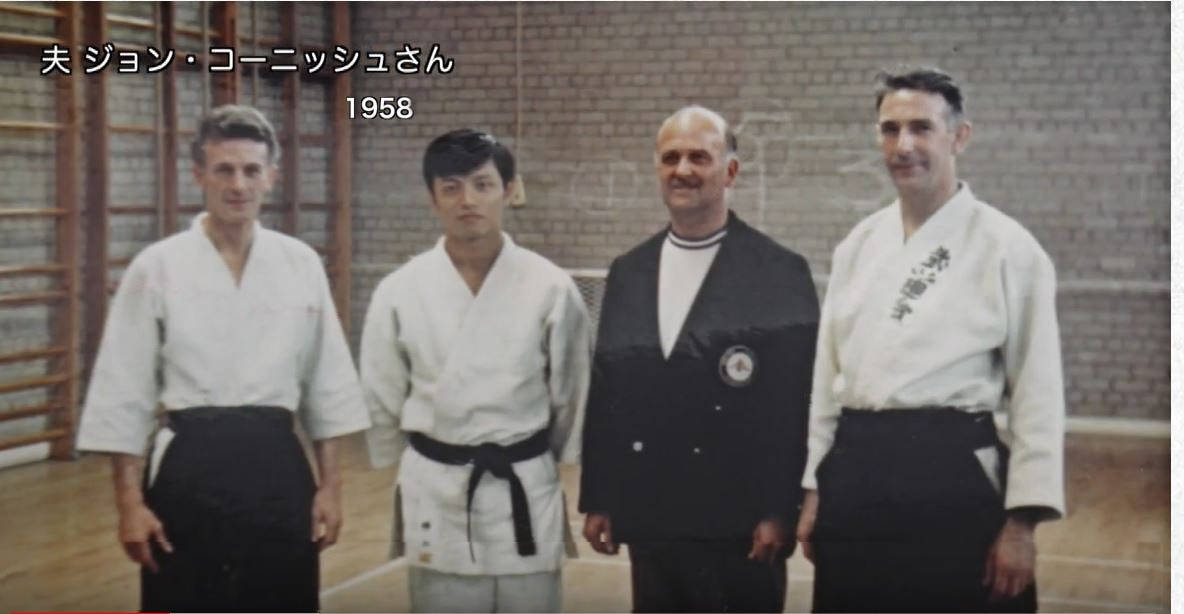John Cornish

John Cornish (28th December 1928 - 11th April 2018).
It is with great sadness that we report the passing of John Cornish who died on Wednesday 11th April. He was a very kind man and a great Judo and Aikido sensei who will be deeply missed.
A message from John's Daughters:-
Dear Family and Friends,
We are gathering to say farewell to our precious
father, John Philip Cornish, who sadly passed away on 11 April 2018.
(Feel free to pass this invite on to anyone who would like to
attend.)
Date & time:
1pm, Saturday 19 May 2018
Location:
Modern Crematorium
City of London Cemetery and Crematorium Aldersbrook
Road London
E12 5DQ
Tel: 020 8530 2151
There will be a gathering afterwards, at the function
room at the cemetery.
We kindly request that you don’t send flowers.
Instead, if you wish to make a voluntary donation in memory of John,
please send to Frog Life (details via link below). As you know, John was
very fond of rearing and caring for the frogs, newts and other wildlife
in his garden. We’d like to carry on his good work.
http://uk.virginmoneygiving.com/SomeoneSpecial/JohnPhilipCornish
Alternatively you can send donations to:
Froglife
Unit 11 Bayford St Industrial Centre
Bayford Street
Hackney
E8 3SE
Best wishes from his daughters - Gina, Janne,
Millaine & Tanya

A Special Sensei – John Cornish (1928 - 2018)
By Diana Birch, Llyr Jones and John Pinnell
Born
on 28th December 1928, judo and aikido kodansha [high grade holder] John
Philip Cornish died on 11 April 2018.
Japanese trained in both arts, John was renowned for his immense
technical knowledge and expertise.
Amongst his many distinctions, he was a titan in judo kata
[forms], and his sad death at the age of 89 represents the passing of
yet another great from the golden age of British judo.
Originally starting judo around 1950, John became a student of Trevor
Pryce (TP) Leggett, one of the leading figures at The Budokwai at that
time. A trailblazer in
post-war judo, John followed the essential path to judo excellence
– an extended period of traditional training in Japan.
Having spent the two prior years accumulating the necessary
finances, diligently studying Japanese in readiness, and of course
practicing hard, he went to Japan in 1959 as a judo shodan.
Enrolling at the Kodokan on 4 June 1959, and skipping shodan, his
promotion history at that institute was 2nd dan on 25 June 1959, 3rd dan
on 29 June 1961 and 4th dan on 17 October 1963.
John
always had a keen interest in kata, and many of the highlights of his
time in Japan, were in this aspect of judo.
His great kata skills were quickly recognised by the Kodokan and
Japanese judo, and between 1961 and 1964 he participated in several kata
demonstrations at prestigious events.
Commonly
he was involved in Nage-no-kata
[Forms of Throwing] demonstrations in the role of Uke, but sometimes he
took the role of Tori too.
Whether as Uke or Tori, it was often the first time that a non-Japanese
judoka had contributed in such a way.
The events where John was Uke included the Tokyo Olympic Games,
the All Japan Judo Championships and the All Japan Industrial Judo
Tournament. It was usually
either the celebrated US budoka Donn Draeger, or Nihon University’s
Saburo Matsushita (now Kodokan 9th dan) who was Tori.
A notable occasion when John was Tori, was when he demonstrated
Nage-no-kata with the Canadian Bob Geddes at the All Japan Police Judo
Championships.
Whilst at the Kodokan, John’s principle kata teacher was Sumiyuki Kotani
(then Kodokan 8th dan, later 10th dan).
John remembered that the legendary Kyuzo Mifune Kodokan 10th dan
once “looked in” when he was training with Draeger, and that he was
unsure whether this was accidental or not.
John noted that Mifune-sensei did not say anything to him or to
Draeger, and thought “well an admiral does not talk to the ordinary
seamen”. He understood
though that Mifune-sensei did pass his thoughts down through the ranks.
When John was training with Matsushita, the pair had help from
Kodokan teachers, and also a kata expert from Nihon University.
He recalled that in one session that particular teacher made them
go through Nage-no-kata three times at full power, which, as Uke, meant
90 hard falls for him. The
teacher then made them do one throw he was unhappy with, fifty times,
and the next day John had little pin-pricks of blood coming out of his
pores where he had impacted with the
tatami [mat].
John used to tell these stories to his own students, to show just
how serious kata training was at that time in Japan.
Whilst in Japan he also studied Kodokan Goshin-jutsu [Kodokan
Self-defence] as a direct student of Kenji Tomiki, who himself had
played a very instrumental role in that exercise’s creation.
John
also studied aikido in Japan
– specifically
at
the Aikido Hombu dojo as a soto-deshi [outside student] (at the same
time as Kazuo Chiba). He
took daily practice with a cast of celebrated teachers
– including
Kisaburo Osawa, Koichi Tohei, Kisshomaru Ueshiba, known as Waka-sensei
[literally, “waka” means “young”, however in this case the term of
“waka” refers to the “successor” the person that will continue after his
father as the international leader of aikido under its hereditary
succession system], and O-sensei [great teacher] Morihei Ueshiba, the
founder of aikido, who graded him.
Off the tatami, John continued his study of Japanese
-
specifically at the Ministry of Foreign Affairs’ [Gaimu-sho] Japanese
language school for foreigners, the Gakuyukai.
It was there he met Ministry employee, Setsuko Kuga (born 1934)
and they married in 1962.
John’s Japanese language skills must have been highly developed, as he
told Diana Birch a story of how he was once in a bookstore in
Tokyo, and the librarian was at the top of a ladder sorting books on the
top shelf. They were
chatting to each other, with the librarian having his back to John.
At one point the librarian turned, and on seeing a gaijin [non-Japanese
person] fell off his ladder in shock.
(John caught him.)
The librarian was so shocked that John spoke such good fluent Japanese –
he thought he was speaking to a local.
Setsuko Kuga Cornish pre-deceased John in 2017, and he is
survived by four daughters
Gina, Janne, Millaine and
Tanya.
Returning to the United Kingdom, after the Olympics, in November 1964,
John taught judo kata and aikido at The Budokwai for over 40 years,
where a countless number of students benefited from his wisdom and
humour. A kindly and
considerate sensei, he always engendered a positive atmosphere on the
tatami, however, drawing on his own experiences in Japan, he always
expected his students to apply themselves and show real effort.
For many years, John was an Honorary National Kata Coach for the
British Judo Association (BJA), and in this role he always emphasised
that the practical demonstration of kata was not important, and that it
was the training and what one learnt from that training that counted.
In 1984 he published a technical booklet for the BJA entitled
“Go-Shin-Jutsu – Judo Self Defence Kata” which is still one of the most
technically detailed English-language resources on Kodokan Goshin-jutsu
available.
After 60 years in budo, John decided to retire from all teaching in
2010. His last lesson was
at The Budokwai on Friday 19 March 2010.
On the occasion of his retirement, many of his judo and aikido
students took to social media to recall some of his more memorable
spontaneous comments during class.
These included:
“If a train is coming what do you do? Get out of the way.”
“Fingers are for gripping.”
“If you have two legs, move two legs. If you have three, move three.”
“You can never be low enough.”
John
Cornish: “Move your left foot forward.”
Student - moves the right one forward
Cornish: “No, the other left foot!”
After demonstrating an advanced technique, musing to himself: “How can it possibly go wrong?”
A
few of his descriptions of attacks in aikido and Kodokan Goshin-jutsu:
“Hold on to his arm with both hands as if you are in the Tube and
are holding the rails trying not to fall!” and “Are you a drinking man?
Good! Then, grab his wrist as if you are grabbing a pint of lager...I
said lager, not wine!”
When
demonstrating a one-handed technique, to keep the other arm out of the
way: “Imagine you are holding the Emperor's baby - you wouldn't drop
the Emperor's baby!” (making a slit throat gesture)

At
the time of his death John held the judo grade of 7th dan – having been
promoted to that rank by the BJA on 1 December 1992.
In his later life was very fond of rearing and caring for the
frogs, newts and other wildlife in the garden of his home in Newham,
London.
Rest
well John, you will be missed by all.
Bulletin - Special Edition Tribute to John Cornish
New issue 35 - A special Tribute to John Cornish